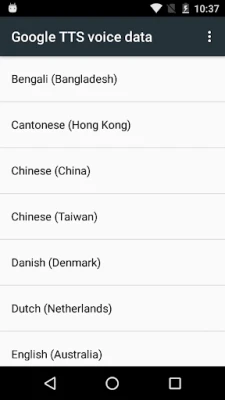
Latest Version
googletts.google-speech-apk_20241125.02_p2.702443970
December 23, 2024
Google LLC
Tools
Android
0
Free
com.google.android.tts
Report a Problem
More About Speech Recognition & Synthesis
Unlocking the Power of Speech Recognition and Text-to-Speech on Android Devices
In today's fast-paced digital world, the ability to convert speech to text and vice versa has become essential. Speech recognition technology allows users to interact with their devices more intuitively, while text-to-speech functionality enhances accessibility and usability. This article explores how these technologies work on Android devices, their applications, and how to set them up for optimal use.
What is Speech Recognition?
Speech recognition technology enables devices to convert spoken language into written text. This functionality is integrated into various applications, making it easier for users to perform tasks hands-free. Here are some common applications of speech recognition:
- Google Maps: Use your voice to search for locations, making navigation simpler and safer.
- Recorder App: Transcribe your voice recordings directly on your device, allowing for easy note-taking and documentation.
- Phone App Call Screen: Get real-time transcriptions of your calls, enhancing communication clarity.
- Accessibility Apps: Utilize Voice Access to control your device entirely through voice commands, improving accessibility for users with disabilities.
- Dictation Apps: Dictate text messages and emails effortlessly, streamlining communication.
- Voice Search Features: Quickly find your favorite shows or songs using voice commands, enhancing your entertainment experience.
- Language Learning Apps: Practice pronunciation and speaking skills as the app recognizes your spoken words.
How to Enable Speech Recognition on Android
To harness the power of Google Speech-to-Text on your Android device, follow these simple steps:
- Open Settings.
- Navigate to Apps & notifications.
- Select Default apps.
- Choose Assist App.
- Set Speech Recognition and Synthesis from Google as your preferred voice input engine.
Understanding Text-to-Speech Functionality
Text-to-speech (TTS) technology allows applications to read text aloud, making information more accessible. This feature is particularly beneficial for users who prefer auditory learning or require assistance due to visual impairments. Here are some popular applications of TTS:
- Google Play Books: Enjoy your favorite books with the "Read Aloud" feature, transforming reading into an auditory experience.
- Google Translate: Hear translations spoken aloud, helping you learn correct pronunciations and improve language skills.
- TalkBack: Receive spoken feedback across your device, enhancing navigation and usability for visually impaired users.
How to Enable Text-to-Speech on Android
To set up Google Text-to-Speech on your Android device, follow these steps:
- Open Settings.
- Go to Languages & Input.
- Select Text-to-Speech output.
- Choose Speech Recognition and Synthesis from Google as your preferred engine.
Keeping Your Speech Recognition and Synthesis Updated
Many Android devices come pre-installed with Google’s Speech Recognition and Synthesis features. However, to ensure you have the latest improvements and functionalities, consider updating to the latest version. You can find updates in the Google Play Store, ensuring your device operates at peak performance.
Conclusion
Speech recognition and text-to-speech technologies are revolutionizing the way we interact with our devices. By enabling these features on your Android device, you can enhance your productivity, accessibility, and overall user experience. Whether you're navigating with Google Maps, transcribing notes, or enjoying an audiobook, these tools make technology more intuitive and user-friendly. Embrace the power of voice and transform your digital interactions today!
Rate the App
User Reviews
Popular Apps










Editor's Choice































